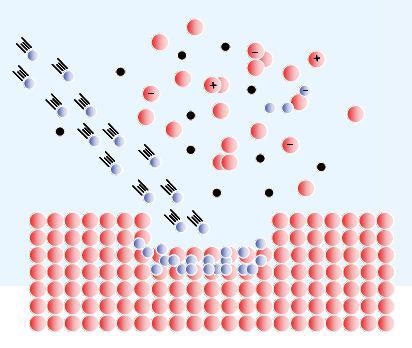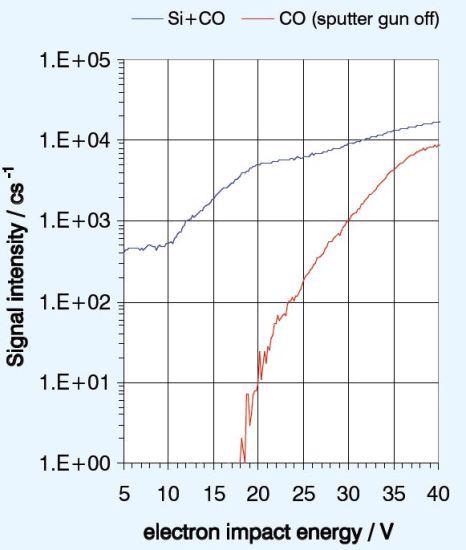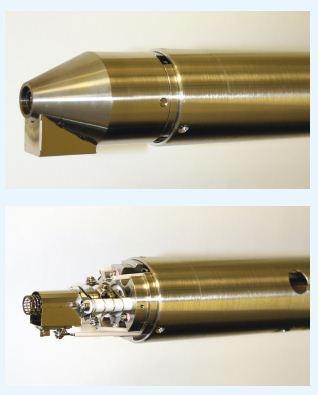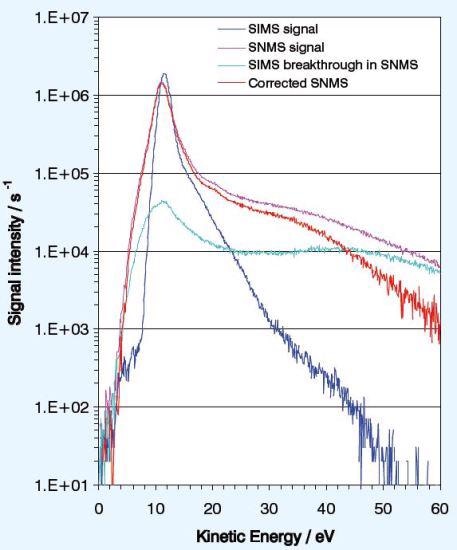Hiden Analytical’s EQS is a high transmission quadrupole secondary ion mass spectrometry (SIMS) detector, featuring a 45° electrostatic, which allows simultaneous analysis of ion energy. The axis of the device is where the ions are collected, making it popular for fitting as an after-market detector, to a wide variety of surface analysis instrumentation.
Typical EQS can be utilized for tracking the residual gas through an electron impact ionizer sited inside the device. This can be utilized to detect sputtered neutrals, though the distance between the sample and the ionizer results in a low sensitivity. Sputtered neutral mass spectrometry (SNMS) is a preferred method, complimenting the SIMS technique it results in rapid and measureable concentration information in the 0.1 to 100 atomic % regime, where the SIMS matrix effect makes direct quantification inconsistent and non-linear.

Figure 1. Incident ion beam (blue) sputters target material with the emission of mainly neutrals and election (black).
SIMS Versus SNMS
Both SIMS and SNMS methods provide mass resolved information for images, concentration depth profiles, and mass spectra. SIMS is appropriate for trace analysis and SNMS suitable for higher concentrations. The combination of these methods offer a powerful quantitative materials analysis approach.
The SNMS technique offers the following benefits:
- Ions are produced by individual ionizer
- Can only be collected by proximity of the ionizer
- Ionized fraction independent of surface chemistry
- Neutrals represent most of the emitted particles
- Needs reference material comprising the preferred element
- Near linear in all concentrations (0.1 to 100 atomic %)
The SIMS technique offers the following benefits:
- Ions are produced by the sputtering event
- Can be easily collected by electric field
- Small fraction of all emitted particles
- Ionized fraction relies on surface chemistry
- Non-linear when concentration is over a few percent
- Needs reference materials of similar chemistry
- Can be measured in range ppb to 5 atomic %
Mass Interference 28Si and CO -Appearance Energy Selection
CO from the residual gas is ionized by the electron impact source. This gas can create a major mass interference at mass 28, but the application of an electron energy less than the appearance energy of CO allows for efficient selection of the Si signal. The blue line indicates the signal determined during the course of sputter analysis, while the red trace indicates the signal due to residual CO in the chamber (Figure 2). Selecting an electron voltage less than the appearance energy of CO, a higher dynamic range can be obtained, regardless of the overall lower signal intensity.

Figure 2. Use of electron energy allows efficient selection of the Si signal.
The Addition of an SNMS Ionizer
The electron impact ionizer is placed in front of the probe to allow it to subtend the largest solid angle possible, as it is not possible to direct the neutrals until they are charged. In SIMS mode, the electrode serves as an extractor for ions and the ionizer filament remains off, while in SNMS mode neutrals are ionized and the ionizer cage is populated with electrons. They then follow a similar path that the SIMS ions would of taken. A bias is placed on the target to deliberately reject the SIMS signal so that the SIMS energy spectrum can be moved to a level where it can be filtered through the electrostatic sector.

Figure 3. Addition of an SNMS ionizer
The filament is enclosed in the box structure underneath the probe, and does not have any line of site to the sample. The electrons, with energy differing from 4 to 150 eV, are directed in to the ionization cage, which can be seen at the end of the device. During operation, the optimum sampling distance ranges from 5 to 10 mm from the end of the probe.
In Use
Turning off the filament and keeping the other potentials the same, allows "breakthrough" SIMS ions to be detected and tracked. This only represents a few percent, even in a high ion yield material like potassium. The data provided was obtained from a natural microcline mineral sample (KAlSi3O8), sputtered using 5 keV Ar+ ions. The 39K signal was detected as a function of kinetic energy and was measured by sweeping the ions transit energy via the electrostatic analyzer (Figure 4).

Figure 4. K signals from microcline
When the sample was insulating, a 500 eV electron flood was employed to render charge compensation. Although this is not needed for neutral analysis, it had to be provided to ensure that high surface potentials do not affect the primary ion beam.
Conclusion
By modifying the Hiden EQS analyzer, energy and mass inspection of fast neutral species can be performed for both basic surface emission studies and materials analysis. Breakthrough ions can be detected through selective measurement when the ionizer filament is off, making it possible to subtract their contribution to the overall outcome.

This information has been sourced, reviewed and adapted from materials provided by Hiden Analytical.
For more information on this source, please visit Hiden Analytical.